I’ve got a twofer to show today!
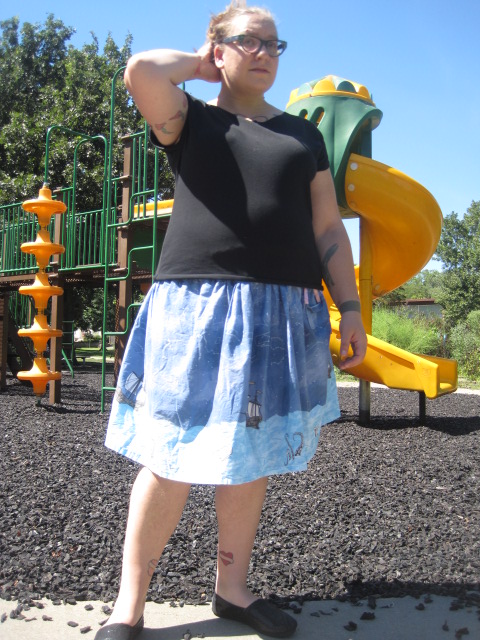
I cannot believe how long it’s taken me to write up these garments. I made the t-shirt in May & I made the skirt in late June. I think the issue is that I wore them constantly all summer, but somehow never managed to get photos before I spilled Ethiopian food or pasta sauce or whatever all over myself. I guess I’m kind of a messy eater.

^^^ Same t-shirt, same skirt, at the Kansas City Zoo in July.
Let’s talk about the t-shirt first, because it’s pretty simple. The pattern is from Blank Slate Patterns, & I think it’s free if you buy another pattern. I picked it up when I bought the Marigold shirtdress for my entry into Indie Pattern Month’s “new to me” challenge.
This is a super-simple tee. It’s just two pieces with cut-on cap sleeves. Raw edges at the hems & neck are turned in & stitched. I did a narrow zigzag at the seamline to help things turn under neatly (a little tip I picked up from Beverly Johnson’s Craftsy class on sewing a supportive one-piece swimsuit). The bottom hem does roll a bit, because I made it VERY narrow. When I make another in jersey fabric, I will have to remember to add a little extra length so I can make a deeper hem.

Despite its simplicity & my usual preference for a banded finish at the hems & neck, I am obsessed with this tee. I don’t know that it would necessarily work for every body, but I love the way it fits me. It shows some shape, but it’s not tight enough to make me self-conscious. The fit is really casual & summer-y. I have been wearing it seriously at least four times a week all summer. I’ve cut another in some gorgeous plum-colored double knit from Style Maker Fabrics. I won a $25 gift certificate to the shop when I won one of the Indie Pattern Month challenges at the Monthly Stitch. (My final winner’s haul for Indie Pattern Month was $25 in free fabric, an instructional DVD on zippers, & nine free patterns from various indie designers–pretty impressive!) This pattern takes less than a yard of fabric (60″ wide) so it’s very economical. & it’s so fast to sew. The only reason my double knit version wasn’t done an hour after I cut it out is because I’ve been dragging my feet on tracking down matching thread.
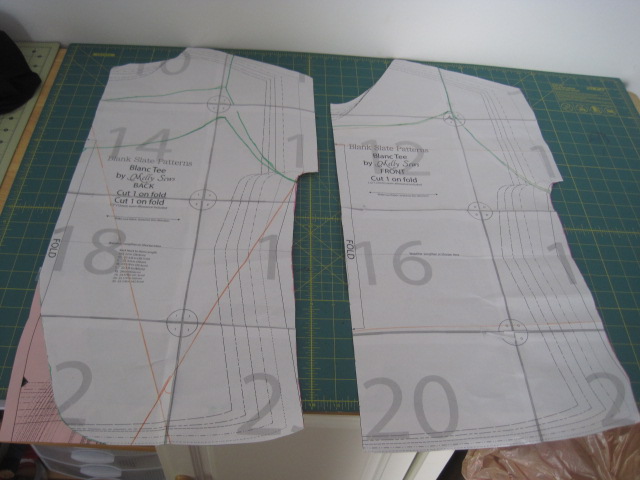
Bottom line: this is not the most sophisticated pattern in the world, but I love the way it looks on me, & when you add in the fact that it was free & it takes an hour to sew…nothing but raves from me.
On to the skirt. This was a featured make-at-home project in “Threads” magazine a couple of months ago. Apparently the pa’u skirt is a traditional native Hawaiian garment often used in hula. It’s usually midi length, & there are three rows of channeling at the waistline. A ribbon is inserted through each & cinched to fit, which also creates dense gathers. There’s only one seam in the garment, at one side, where the ribbons are fed.
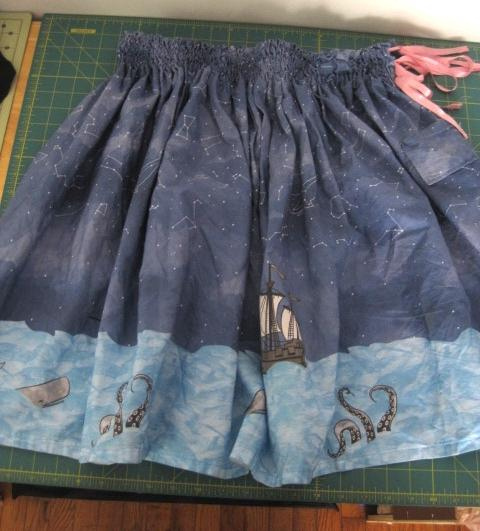
I had some qualms about making this skirt, & I’d love some opinions. Given that this is a traditional garment from a culture that I am not a part of, & which is not a privileged culture, social justice-wise, it seemed like maybe it was culturally appropriative of me to make it. I asked Jared for his input, & he voted that it was culturally appropriative. Obviously I made it anyway, because I had my eye on this fabulous border print & was already planning to use it for some kind of a dirndl skirt. This skirt has the whole ribbon element, & I loved the dense gathering at the waistline (even though it definitely adds bulk in an area where I require no assistance)…I am basically helpless when it comes to ribbon. I’ll make practically anything if I can use ribbons.
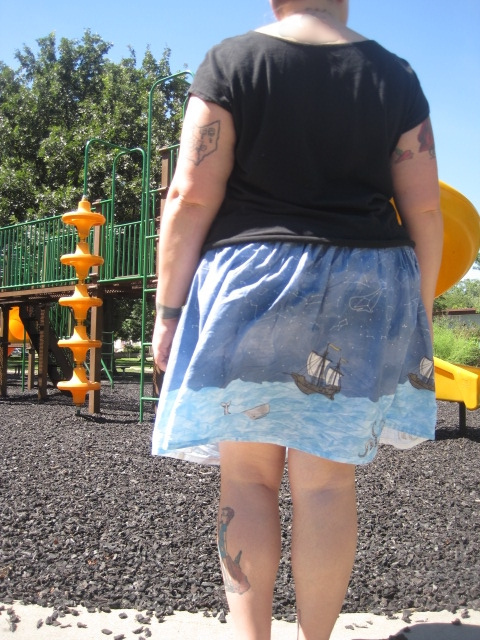
The crossroads of fashion & cultural appropriation are difficult & thorny. There are a lot of styles that have made their way into “mainstream” (read: white) fashion that began in the traditional designs of marginalized cultures. Some of the styles are used specifically to evoke the marginalized culture, like dresses with cheong-sam styling (think frogs & maybe a stand collar) or heavily embroidered poblana-style blouses (thank you, Mexico). But some elements have basically become completely assimilated into mainstream fashion (kimono sleeves, for instance).
& it’s a constant issue for privileged Western white people to just buy (or make) the styles that appeal to them & never stop to consider the fact that they may be appropriating a really important part of a marginalized culture. Consider, for instance, the Navajo Nation suing Urban Outfitters for slapping their name all over clothing made in vaguely “tribal” prints. (Consider “tribal” prints in general.)
So. These are the thoughts I had while making this skirt. I still feel unresolved on the issue. Obviously this style of skirt is important to hula culture, & hula culture is important to a race of people who were colonized & exploited. Am I contributing to that exploitation by making this skirt, just because I think it’s cute? Maybe.
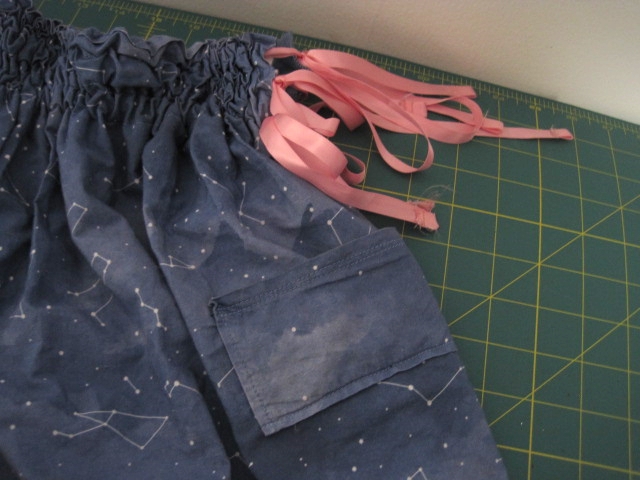
I do like the skirt, & I wear it constantly, & I get loads of compliments every time. (I think people just really like the print, & a one-seam gathered skirt is an ideal way to showcase a fabulous border print.) I used a full three yards in width, but I shortened it a bit so it’s knee-length or a little above (depends on where I wear the waistband). I also did the ribbon treatment the same way I did on my Anderson blouse, by sewing ribbon to 1/4″ elastic, to give the waist a little stretch & facilitate being able to put it on & take it off without untying. I made the ribbon a little long for the bottom tier, a little longer for the middle, & longest at the top, so they all fall to about the same length.

The fabric is a laser printed print from the Hawthorne Threads in-house line. It comes in a pretty big selection of colors. I honestly had a hard time choosing. A warning to those who may be tempted to order Hawthorne Threads prints for garments: the print is indeed 44″ wide, as advertised, but the selvages are enormous. The average selvage is like an inch. Each selvage on these bad boys was like 10″. The fabric also feels a lot more stiff than your average high-quality quilting cotton. I was not thrilled with the hand or the drape at first. Washing it made it a little softer, but it was still really stiff, & all the gathering on this skirt requires a certain degree of drape, you know? But like I said, I’ve been wearing it, & hence, washing it, all summer & it’s softened up a lot.

I applaud your consideration of cultural appropriation, and being of white colonial descent myself I can’t offer any approval or pass as to whether or not this constitutes appropriation or not, or how it may be perceived by people of the culture it belongs to. I would like to think however that your consideration and careful treatment of the heritage of this garment constitutes a lack of appropriation and rather a respectful honouring and homage of a traditional garment from a culture other than your own.
The t-shirt is fair game though and I’m well impressed with your neck edge. I have the worst time sewing stretch hems and usually always self bind stretch necks. Any tips?
I do think sewing a narrow zigzag right at the seamline helped. The jersey wanted to turn under at that line & since the zigzag stretched it a little, it took the straight stitch really well. I think it was mostly dumb luck though.
I don’t know that I necessarily get a pass just because I thought about the cultural appropriation issue. I mean, when I am walking down the street as a white person in a pa’u style skirt (though I don’t know if people can tell from afar that it’s a pa’u or if it looks more like a regular gathered waist dirndl, since I am not a big fan of tucking in my shirts), a person can’t tell that I have considered the issue. & even if they could somehow magically read my mind & see that I have thought about it…I still made it & am wearing it. Which, if you want to be deeply uncharitable (& I think people of color have every right to be uncharitable to white people), means that I thought, “Is this cultural appropriation? Maybe? Oh well!”
I’ve heard people make the argument, “It’s not culturally appropriation! It’s cultural APPRECIATION!” & I don’t presume to speak for any people of color here. But I think a cogent argument could be made for appreciating with your eyes rather than your hands, so to speak.
This is very true. You can have a tag on the outside that says “I made this garment respectfully and with consideration and appreciation of your culture”.
Ha! That would be pretty awkward.
*Can’t NOT can – stupid fingers typing wrongly
I love the print on the skirt. They both look fabulous on you. I am not sure if I have any input on the design and whether it is cultural appropriation. It’s an absolutely gorgeous style of skirt, though, and looks fabulous with border prints. I had these thoughts while making my wax print-esque maxi dress. I’m not sure where the border of cultural appropriation is crossed and worry that some side glances when I wear the dress are because of that. I think that your skirt doesn’t look obviously like a pa’u skirt in that you have a shorter waistband and aren’t using Hawaiian prints, but I have no clear answer on if the design is enough to push cultural appropriation. I wish I knew. 😦
I hear you on the cultural appropriation thing. I went wax print crazy last year and bought five wax prints, but I’ve only sewn two of them because I feel uneasy about them. I wrote about it on my blog when I wrote about the first fabric I used. I think wax prints are even more problematic because of their complicated history, which I didn’t know about until I after I bought them (I totally should have research this stuff before jumping into purchasing the fabric): the Dutch stole wax printing techniques from Indonesians in attempt to sell the fabrics to Indonesians cheaper than what they could buy locally – a common technique of colonists everywhere, as I’m sure you know. The Indonesians refused to buy them (I’m glad they were able to resist – so many other colonized peoples weren’t) so the Dutch found a market for them in Africa instead, which remains today. So I feel like buying these fabrics is supporting an industry created to steal from colonized people and then sold to another group of colonized people, and then is culturally appropriative on top of that. I see the “appreciative” argument – I guess it’s good that we don’t scorn designs and techniques from people of color and consider them less than. But really, what we (as white people) been doing all along is appreciating those designs and techniques when they’re made by white people and scorning them when they’re made by people of color. I continually discover more things that are commonplace in white American culture that were stolen from Black slaves or from other cultures. So the appreciative argument doesn’t hold too much water in my opinion. I’ve gained too much weight to fit into my wax print dresses since I made them, so this isn’t an issue I’ve had to face recently. And I’ve avoided sewing up my remaining three because of my trepidation. I do feel like your skirt is different because you’ve decided to use a smart and effective technique to create a pretty standard item (dirndl skirt) rather than copying the style of the pa’u skirt wholesale, but I don’t know if I’m just making excuses. And I’m obviously not the person who should get to decide on this issue anyway.
On a different note, I’m glad your Hawthorne Threads fabric is softening up. I sewed mine up last week and there is a fit issue that I didn’t deal with in my first version of the pattern because it wasn’t that severe, but it’s quite obvious in HT fabric because it’s so stiff. And there’s no way to fix it, so that’s irritating. Maybe if it softens up it won’t look so bad.
I went back and read your post – you really cleared a few things up for me about African wax prints. I’d been umming and ahhing over them (so pretty! But racist?) for a long time, so I’m glad I know a bit more about their background before I rushed out to buy some.
Yeah, I am definitely not at all ambivalent about considering wax prints problematic for white people.
Yeah, I knew all that about wax prints, though I can’t remember when or where I learned it. Maybe before I ever started sewing? It’s definitely a big reason why they have never tempted me. The entire sewing blogosphere kind of went wild for wax prints last year, & I was like, whoa, do people not know? I never said anything about it because I’m not sure how to address that stuff with sewing people. The people I know from feminist/zine stuff are obviously very political & would want to know, or at least I would feel comfortable bringing it up, even if it wasn’t well-received. Obviously a lot of sewing people are also feminist/radical & want to know/discuss these things, but it’s hard to guess who those people might be just by reading their blogs. I did post a question about cultural appropriation on one sewing blog. I don’t remember the circumstances. It was something like a white blogger who made a skirt from a sugar skull print or something. Her response was pretty defensive, & you know, I was just a random person who read her blog. We didn’t have any kind of relationship, so I didn’t feel comfortable pressing the issue.
I think Hawthorne Threads fabric is kind of like linen in that it has a surprising amount of body, but does soften up with wear & washing. Hopefully yours relaxes soon.
Yeah, I am totally at fault for not researching the fabrics before I bought. I think I was in a bit of a frenzy because I love some of the prints, and I was rationalizing that they were probably okay because so many people in the sewing community were buying them, but that quite obviously makes zero sense. I have some weaknesses as a consumer for sure.
I washed my fabric a second time and it does seem to have softened up considerably. I wore the dress before washing it that second time, and it was less annoying/uncomfortable than I thought it would be, so it wasn’t a huge deal, but I’m glad it’s softened up anyway.
I mean, some of the prints, & especially the colors, are really pretty. I can understand the allure, especially when you see “everyone else” doing it. It’s hard. I guess it’s also hard for me to respond to blog comments in a timely fashion. Hello, comment from almost a month ago!
I’ve been thinking about your comments on cultural appropriation. Firstly, thank you! It is rare to read these kinds of discussions on sewing blogs. I don’t quite know the answer to your quandary, being a privileged white person (especially in a country where Indigenous peoples are treated appallingly), and having the same kinds of questions myself.
Tribal headgear at festivals? Wanker. Dreadies on a white lady? You bet I’m going to judge the shit out of you. But with something like this skirt, which is so close to the kinds of gathered skirts that are worn frequently in Western societies…..I dunno. But then, did we get our gathered skirt inspiration from German dirndls? How Western are they? Eh. I guess it’s up to the people of the culture in question to decide, and up to us to shut up and listen.
Yes, dirndls are definitely a German inspiration, but you know…Germans are white Europeans. Not exactly a marginalized group.
You’re right though, that it’s not really up for a bunch of white people to form a committee & decide what is & is not acceptable around this issue. I’m glad so many people have joined the conversation though. It’s definitely good for us to be thinking about that stuff, because there are a lot of opportunities to get tripped up by this stuff in sewing & fashion, & I think it’s not thought or talked about enough.
I think the choice of fabric makes a big difference. With that fabric, nothing about that skirt screams “pa’u” to me. Maybe I’d feel differently if you’d used some vaguely tropical-y fabric? I am bad at this stuff.
Yeah, I absolutely never would have considered a tropical print. There’s just no doubt, that is clear cultural appropriation.